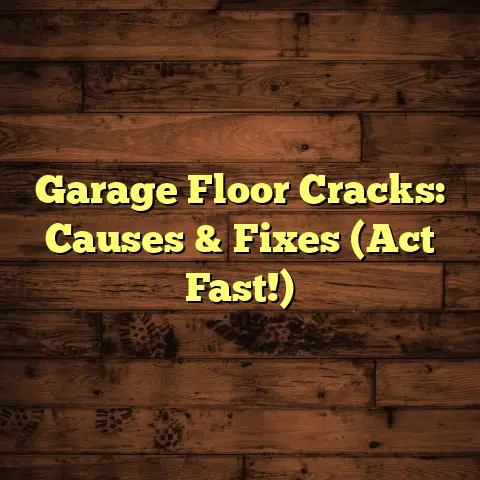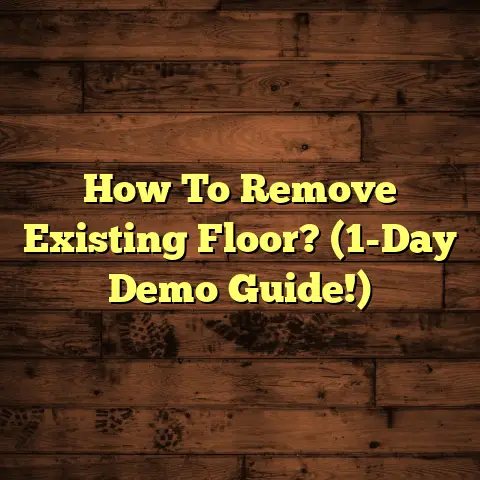How To Attach Hardwood Floor To Concrete?
I’m excited to share my expertise on a topic near and dear to my heart: hardwood flooring.
There’s just something about the warmth and classic beauty of hardwood that transforms a house into a home, don’t you think?
Hardwood floors bring a cozy and inviting atmosphere, enhancing the aesthetic appeal of any space.
Plus, they’re durable and surprisingly easy to maintain.
And when you combine the natural charm of wood with the solid foundation of concrete, you get a match made in home improvement heaven.
That’s right, I’m talking about attaching hardwood floors to concrete!
It’s a popular choice, and for good reason.
In this guide, I’ll walk you through every step of the process, from prep work to the final touches, so you can achieve a successful and stunning installation.
We’ll cover:
-
Understanding the Basics: Solid vs. engineered hardwood, concrete subfloor characteristics, and why this method works.
-
Preparing for Installation: Tools, materials, concrete prep, and acclimating your wood.
-
The Installation Process: Choosing the right adhesive and a detailed, step-by-step guide.
-
Post-Installation Care: Curing time, maintenance, and troubleshooting common issues.
Ready to dive in? Let’s get started!
Section 1: Understanding the Basics of
Hardwood Flooring and Concrete
1. Types of Hardwood Flooring
First things first, let’s talk about the different types of hardwood you’ll encounter.
The two main categories are solid hardwood and engineered hardwood.
Solid Hardwood:
This is exactly what it sounds like – planks made from a single piece of wood.
Think oak, maple, cherry, and walnut.
-
Advantages: Can be refinished multiple times, adding to its lifespan. It also has a classic, authentic look.
-
Disadvantages: More susceptible to moisture and temperature changes, which can cause warping or expansion. This makes it less ideal for direct installation on concrete, especially in damp basements.
Engineered Hardwood:
Engineered hardwood is constructed from multiple layers of wood veneer glued together, with a solid hardwood layer on top.
-
Advantages: More stable than solid hardwood, less prone to expansion and contraction, and better suited for concrete subfloors. It can handle moisture fluctuations better.
-
Disadvantages: Can only be refinished a limited number of times (depending on the thickness of the top layer) and might not have the same “feel” as solid wood for some purists.
When it comes to installing on concrete, engineered hardwood is generally the better choice because of its stability.
2. Concrete Subfloors
Now, let’s talk about concrete. Your concrete subfloor isn’t just a slab of cement; it’s a crucial element in your flooring project.
Here’s what you need to know:
-
Characteristics: Concrete is porous and can absorb moisture from the ground. It’s also hard and unyielding, meaning it doesn’t provide any “give” like a wood subfloor.
-
Moisture Levels: This is critical. Excessive moisture in concrete can wreak havoc on hardwood floors, causing them to warp, buckle, or even develop mold.
According to the Portland Cement Association, the acceptable moisture emission rate for installing hardwood flooring is typically 3 lbs per 1,000 square feet over 24 hours when using a calcium chloride test.
What does that mean? Well, you need to test the moisture level before you even think about laying down your beautiful new floor.
I’ll explain how to do that in the next section.
-
Levelness: Concrete subfloors are rarely perfectly level. Any significant dips or bumps need to be addressed to ensure a smooth, even flooring surface.
3. Why Attach Hardwood to Concrete?
So, why go through the trouble of attaching hardwood to concrete in the first place?
Here are a few compelling reasons:
-
Stability: When properly installed, hardwood attached to concrete provides a stable and solid flooring surface.
-
Aesthetics: You get the beauty and warmth of hardwood in areas where you might otherwise be limited to tile or laminate.
-
Cost-Effectiveness: In some cases, it can be more economical than building a traditional wood subfloor over concrete.
This installation method is ideal in scenarios like:
-
Basements: Where concrete slabs are common.
-
Slab Homes: Homes built directly on a concrete foundation.
-
Renovations: When you want to upgrade from existing concrete flooring.
Section 2: Preparing for Installation
Alright, now that we’ve covered the basics, let’s get down to the nitty-gritty of preparation.
This is where the success of your project is truly determined.
Trust me, don’t skip these steps!
1. Tools and Materials Needed
Here’s a comprehensive list of what you’ll need:
Tools:
- Pry Bar: For removing existing flooring or trim.
- Circular Saw or Miter Saw: For cutting hardwood planks.
- Tape Measure: Accurate measurements are crucial.
- Moisture Meter: To test the moisture content of the concrete.
- Straightedge: For checking the levelness of the concrete.
- Trowel: For applying adhesive (choose the correct notch size for your adhesive).
- Rubber Mallet: For tapping planks into place.
- Spacers: To maintain consistent expansion gaps.
- Roller (Heavy): To press the planks firmly into the adhesive.
- Safety Glasses and Gloves: Safety first!
Materials:
- Hardwood Flooring: Solid or engineered, depending on your preference and the concrete’s moisture level.
- Flooring Adhesive: Specifically designed for attaching hardwood to concrete.
- Moisture Barrier (if needed): A plastic sheet or liquid membrane to prevent moisture migration.
- Self-Leveling Compound (if needed): To correct unevenness in the concrete.
- Baseboards and Trim: To complete the finished look.
- Wood Filler: To fill any gaps or imperfections.
2. Preparing the Concrete Subfloor
This is where the real work begins.
Follow these steps carefully:
-
Cleaning: Thoroughly clean the concrete surface. Remove any dirt, dust, debris, paint, or old adhesive residue. I recommend using a concrete grinder or scraper for stubborn residue.
-
Leveling: Use a straightedge to check for any unevenness. If you find dips or bumps greater than 3/16 inch over a 10-foot span, you’ll need to apply a self-leveling compound.
Follow the manufacturer’s instructions carefully when using self-leveling compound.
-
Moisture Testing: This is the most critical step. You must test the moisture level of the concrete before proceeding.
There are a few ways to do this:
-
Calcium Chloride Test: This involves placing a measured amount of calcium chloride on the concrete surface under an airtight dome for a specific period (usually 72 hours). The amount of moisture absorbed by the calcium chloride indicates the moisture emission rate.
This is a reliable method, but it takes time.
-
Electronic Moisture Meter: These meters use electrical resistance to measure moisture content. They’re faster than the calcium chloride test, but can be less accurate.
Always calibrate your meter and take multiple readings across the floor.
If the moisture level exceeds the manufacturer’s recommendations for your chosen adhesive and flooring, you’ll need to install a moisture barrier.
This could be a plastic sheet (polyethylene film) or a liquid-applied membrane.
Follow the manufacturer’s instructions carefully for the moisture barrier.
-
3. Acclimating Hardwood Flooring
Hardwood is a natural material, and it needs time to adjust to the environment in which it will be installed.
This process is called acclimation.
-
Why Acclimate? Acclimation allows the wood to expand or contract to match the temperature and humidity levels of your home.
-
How Long to Acclimate? The general rule of thumb is to acclimate hardwood flooring for at least 3-5 days before installation.
However, the exact time will depend on the species of wood, the thickness of the planks, and the humidity levels in your home.
Check the manufacturer’s recommendations for specific guidelines.
-
Acclimation Conditions: Store the hardwood flooring in the room where it will be installed.
Keep the temperature and humidity levels consistent with your normal living conditions.
Ideally, the temperature should be between 60-80°F (15-27°C) and the relative humidity between 30-50%.
Stack the planks in a way that allows air to circulate freely around them.
Section 3: Installing Hardwood Flooring
Over Concrete
Okay, the moment we’ve all been waiting for!
Let’s get that hardwood installed.
1. Choosing the Right Adhesive
Selecting the right adhesive is crucial for a long-lasting and successful installation.
Here are some factors to consider:
-
Type of Hardwood: Different adhesives are formulated for different types of wood.
Make sure to choose an adhesive that is specifically recommended for your chosen hardwood species and construction (solid or engineered).
-
Moisture Content: If your concrete has a slightly elevated moisture level, you may need to use an adhesive with a built-in moisture barrier.
-
VOC Content: Consider the volatile organic compound (VOC) content of the adhesive.
Low-VOC adhesives are better for indoor air quality.
-
Manufacturer’s Recommendations: Always follow the adhesive manufacturer’s recommendations for application, curing time, and coverage.
Some popular types of adhesives for attaching hardwood to concrete include:
-
Polyurethane Adhesives: Strong, durable, and moisture-resistant.
-
Modified Silane Polymer (MSP) Adhesives: Excellent adhesion, low VOCs, and good moisture resistance.
-
Acrylic Adhesives: Water-based, low VOCs, and easy to clean up.
2. Step-by-Step Installation Process
Alright, let’s get to it!
Here’s a detailed step-by-step guide to installing hardwood flooring over concrete:
-
Step 1: Mark the Layout:
-
Determine the direction in which you want to lay the flooring.
Typically, it’s best to run the planks parallel to the longest wall in the room.
-
Use a chalk line to mark a straight reference line on the concrete.
This will help you keep the planks aligned.
-
Remember to account for expansion gaps along the walls.
I typically use 1/4- to 3/8-inch spacers.
-
-
Step 2: Apply the Adhesive:
-
Using the recommended trowel (notch size is crucial – check the adhesive manufacturer’s specs!), apply the adhesive to the concrete in a consistent layer.
-
Work in small sections (about 2-3 feet wide) to prevent the adhesive from drying out before you can lay the planks.
-
-
Step 3: Lay the Hardwood Planks:
-
Begin laying the planks along your reference line, starting in a corner of the room.
-
Press each plank firmly into the adhesive, ensuring good contact.
-
Use a rubber mallet to gently tap the planks into place, ensuring they are tightly butted together.
-
Use spacers along the walls to maintain the expansion gaps.
-
-
Step 4: Roll the Planks:
-
After laying a section of planks, use a heavy flooring roller to press them firmly into the adhesive.
This helps eliminate air pockets and ensures a strong bond.
-
-
Step 5: Allow the Adhesive to Cure:
-
Follow the adhesive manufacturer’s instructions for curing time.
Typically, it takes 24-72 hours for the adhesive to fully cure.
Avoid walking on the floor during this time.
-
-
Step 6: Install Baseboards and Trim:
- Once the adhesive is fully cured, install baseboards and trim to cover the expansion gaps and create a finished look.
3. Tips for a Successful Installation
Here are a few extra tips to help you achieve a smooth and professional installation:
-
Work in Sections: Don’t try to apply adhesive to the entire floor at once.
Work in small, manageable sections to prevent the adhesive from drying out.
-
Stagger the Seams: Stagger the end seams of the planks to create a more visually appealing and structurally sound floor.
-
Use a Tapping Block: When tapping planks together, use a tapping block to protect the edges of the planks from damage.
-
Clean Up Excess Adhesive: Wipe up any excess adhesive immediately with a damp cloth.
-
Be Patient: Don’t rush the process.
Take your time and pay attention to detail.
Section 4: Post-Installation Care and
Maintenance
Congratulations! You’ve successfully installed your hardwood floor.
Now, let’s talk about how to keep it looking beautiful for years to come.
1. Curing Time
As I mentioned earlier, it’s crucial to allow the adhesive to cure properly before subjecting the floor to heavy foot traffic.
-
Factors Affecting Curing Time:
- Temperature and humidity levels.
- Type of adhesive.
- Thickness of the adhesive layer.
-
General Guidelines:
- Avoid walking on the floor for at least 24 hours after installation.
- Keep heavy furniture off the floor for at least 72 hours.
- Follow the adhesive manufacturer’s recommendations for specific curing times.
2. Regular Maintenance
Proper maintenance is essential for preserving the beauty and longevity of your hardwood floor.
Here are some tips:
-
Regular Cleaning:
- Sweep or vacuum the floor regularly to remove dirt and debris.
-
Use a damp mop with a pH-neutral hardwood floor cleaner to clean the floor.
Avoid using excessive water, as this can damage the wood.
-
Protective Measures:
- Place mats at entrances to trap dirt and moisture.
- Use felt pads under furniture legs to prevent scratches.
- Avoid wearing shoes with sharp heels on the floor.
-
Humidity Control:
-
Maintain a consistent humidity level in your home to prevent excessive expansion or contraction of the wood.
Use a humidifier or dehumidifier as needed.
-
Aim for a relative humidity between 30-50%.
-
3. Common Issues and Solutions
Even with the best installation and maintenance, you may encounter some issues with your hardwood floor over time.
Here are a few common problems and how to address them:
-
Warping:
- Cause: Excessive moisture.
- Solution: Identify and address the source of the moisture. Consider using a dehumidifier. In severe cases, you may need to replace the affected planks.
-
Squeaking:
- Cause: Movement between the planks and the subfloor.
- Solution: Inject adhesive into the gaps between the planks and the subfloor.
-
Gaps:
- Cause: Contraction of the wood due to low humidity.
- Solution: Increase the humidity in your home. Use wood filler to fill small gaps.
Conclusion
And there you have it!
A comprehensive guide to attaching hardwood flooring to concrete.
I know it seems like a lot, but trust me, with careful preparation and attention to detail, you can achieve a stunning and long-lasting result.
Remember, the key is to:
- Choose the right type of hardwood (engineered is usually best for concrete).
- Thoroughly prepare the concrete subfloor.
- Acclimate the hardwood properly.
- Use the correct adhesive.
- Follow the installation steps carefully.
- Maintain the floor regularly.
By following these guidelines, you’ll be able to enjoy the warmth and beauty of hardwood flooring in your home for many years to come.
So, go ahead and embrace the challenge!
With a little hard work and creativity, you can transform your space into a cozy and inviting haven.
Happy flooring!





